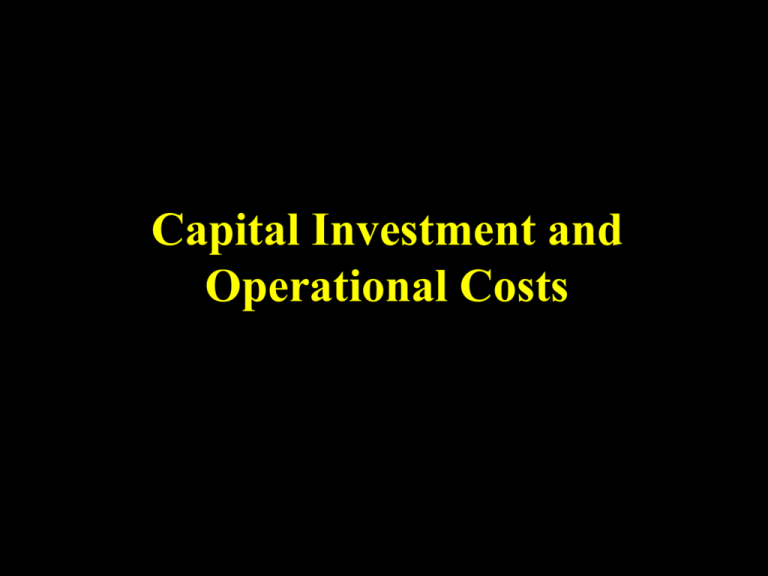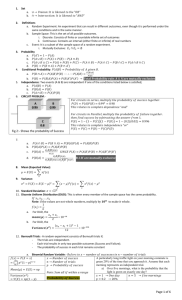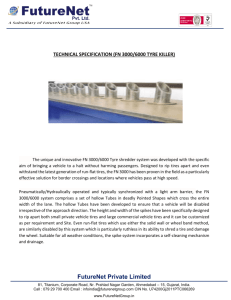Lecture 7: Capital Investment and Operational Costs
advertisement

Capital Investment and Operational Costs Introductory Comments • Cost = anything that reduces your business objective • Benefit = anything that contributes to it • Two types of costs: investment (capital costs) and operational (on-going) General Assumptions • If you wish to assess the future success of your project, you must make several assumptions. • Assumptions will allow calculations to be completed and conclusions to be drawn. • Do you have access to unlimited capital (funding)? Will there be taxes to consider. • Others: market prices, dimensions/operational parameters, cost/amount of material, construction labor, utilities, etc. • Market prices are the most influential! Doc K’s Assumptions… • I’ll be building a large flounder fingerling production farm. (Flounder Effect) • I don’t have land. • Semi-intensive technology • I need bank loan! • I don’t have the company formed yet! Investments (Costs) • Preliminary (meetings, legal, land) • Construction (excavation, structures, buildings) • Equipment (vehicles, lab, etc.) Preliminary Investments INVESTMENT COST (US$) PLANNING 30,000 LEGAL FEES 16,000 PREFEASIBILITY 30,000 BUSINESS PLAN, FEASIBILITY 50,000 DRAWINGS AND MAPS 20,000 LAND REGISTRATION 18,000 LAND PURCHASE (420 ha, 170 a)* 420,000 TOTAL PRELIMINARY COSTS 584,000 * REMEMBER, ALTHOUGH OUR FARM HAS 300 HA, 120 a OF PONDS, MORE LAND IS NEEDED Spreadsheet 1- Preliminary Activities Capital Investment Year 1 Month 1 Month 2 Month 3 Month 4 Month 5 Month 6 Month 7 Month 8 Month 9 Month 10 Month 11 Month 12 Total Preliminary Activities General Planning Legal Fees Prefeasibility Business Plan/Feasibility Construction Drawings Land Registration Fee Land Purchase 30,000 16,000 30,000 50,000 20,000 18,000 420,000 Total, Preliminary Activities 584,000 30,000 16,000 30,000 50,000 20,000 18,000 420,000 + $10% contingencies = $642,000 Next: Construction Investment, Equipment Investment 584,000 Construction Costs • • • • Earth movement ($1.00 - $2.00/cubic m) Pumping station (a lot of concrete) Water control structures (inflow/harvest gates) Ancillary buildings (office, housing, kitchen, cafeteria/break room, ice plant, etc.) • Costs highly reflective of local conditions and is usually one of the highest costs… Earthmoving Costs • Use of heavy machinery to clear, shape land • Along with land = largest single costs you will face (30-50%) • Typically calculated as 15% of total pond area as volume • Thus, 300 ha = 3 million sqm, 3 million x .15 = 450,000 cubic meters • @ $1.50 per cubic meter = $675,000 Pumps/Pumping Station • Also a major expense… • Number of pumps, size of the installation is determined by stocking density • 15% daily max exchange for a semi-intensive 300 ha farm with 1.25 m deep ponds, pumping 16 hours per day is 186,000 gpm • If each pump has a capacity of 40,000 gpm, we need at least five (one extra for redundancy, 6 x $60,000 = $360,000) • The pumping station must support this weight and therefore is almost solid concrete ($200,000) Water Control Structures • Gates/wiers are used to distribute/control water flow to farm • Concrete construction & large (sediment pond gates), inflow type (filtering) and harvest type (effluent, harvesting) • Most ponds have two inflow gates ($1,000 ea) and one harvest gate ($2,000 ea) • Our farm will have 30, ten ha ponds: 2 sediment ponds gates ($5,000 ea, total of $10,000), 60 inflow gates (total of $60,000) and 30 harvest gates (total of $60,000) • Total construction investment for water control structures: $130,000 Ancillary Facilities • • • • • • • • • • Ice plant (20 tons per day, used $70,000) Freshwater well (150 gpm, $20,000) Feed storage building ($15,000) Fry acclimation center ($30,000) Equipment storage ($15,000) Mechanics shop ($10,000) Office/Lab ($10,000) Housing ($25,000) Kitchen/cafeteria ($10,000) Guard houses ($5,000) TOTAL = $210,000 Spreadsheet 1: preliminary, construction investment Capital Investment Year 1 Month 1 Month 2 Month 3 Month 4 Month 5 Month 6 Month 7 Month 8 Month 9 Month 10 Month 11 Month 12 Total Preliminary Activities General Planning Legal Fees Prefeasibility Business Plan, Feasibility Construction Drawings, etc. Land Registration Fees Land Purchase Total, Preliminary Activities Construction Activities Earthmoving Pumps/Pump Station Water Control Structures Ancillary Buildings Total, Construction Activities 30,000 16,000 30,000 50,000 20,000 18,000 420,000 584,000 30,000 16,000 30,000 50,000 20,000 18,000 420,000 584,000 675,000 560,000 130,000 210,000 1,575,000 675,000 560,000 130,000 210,000 1,575,000 + 10% Contingencies ($157,500) = $1,732,500 Next: Equipment Investment Note: So far, you are at the $2,000,000 investment level and not finished. NOTE: THIS SPREADSHEET IS BEING BUILT AS I GO! Equipment Investment TYPE Pond preparation Fry acclimation Feeding Vehicles Tractors, trailers Trucks Boats Laboratory Harvesting Housing, kitchen, cafeteria COST (US$) 12,000 20,000 20,000 40,000 100,000 20,000 15,000 50,000 20,000 TOTAL = $317,000 Plus contingencies = $348,700 huh??? Spreadsheet 1: preliminary, construction, equipment investment SPREADSHEET 1: CAPITAL INVESTMENT (COSTS) Preliminary Activities General Planning Legal Fees Prefeasibility Business Plan, Feasibility Construction Drawings Land Registration Fees Land Purchase Sub-total, Prelim. Activities Contingencies (10%) Total, Preliminary Activities Construction Activities Earthmoving Pumps/Pump Station Water Control Structures Ancillary Buildings Sub-total, Construction Act. Contingencies (10%) Total, Construction Activities Equipment Purchases Pond preparation Fry/acclimation Feeding Vehicles Laboratory Harvesting Housing, etc. Sub-total, Equipment Contingencies (10%) Total, Equipment Purchases Total Investment Costs Year 1 Month 1 30000 16000 30000 50000 20000 18000 420000 584000 58400 642400 Month 2 Month3 0 0 0 0 21000 21000 2100 23100 140000 21666 21000 182666 18266.6 200933 168750 21000 189750 18975 208725 Month 4 0 0 Month 5 0 0 Month 6 Month 7 0 0 0 0 21667 21000 42667 4266.7 46934 140000 21667 21000 182667 18266.7 200934 20000 10000 10000 20000 168750 21666 21000 211416 21141.6 232558 Month 8 0 0 Month 9 0 0 Month 10 0 0 Month 11 0 0 168750 140000 21667 21000 182667 18266.7 200934 Month 12 Total 0 0 30000 16000 30000 50000 20000 18000 420000 584000 58400 642400 168750 140000 21667 21000 211417 21141.7 232559 21000 161000 16100 177100 21000 21000 2100 23100 0 0 0 168750 16875 185625 12000 20000 10000 40000 20000 10000 20000 15000 40000 50000 10000 80000 8000 88000 2723600 0 0 0 0 0 0 0 0 0 20000 2000 22000 20000 2000 22000 40000 4000 44000 10000 55000 5500 60500 0 0 0 0 0 0 62000 6200 68200 40000 4000 44000 675000 560000 130000 210000 1575000 157500 1732500 12000 40000 20000 160000 15000 50000 20000 317000 31700 348700 Contingency Costs? • These are increases in line item costs based upon the probability that something could (will) go wrong! • Can’t predict future! Even in a budget. • Especially true for developing countries, areas where inflationary rates are high or material availability is variable (REM: Generator story??) • +10% investment = contingency costs • This increases our total investment costs to over $2,723,600 (nice, eh?) (2) Operational Costs • Operational costs: day to day costs of production • Outlay of funds for inputs, services used in production • for short-run financial analyses, total costs include fixed and variable costs • fixed cost: one that does not change during production period (how can this differ?) • examples: land taxes, principal and interest on loans, insurance premiums, sometimes salaries, permitting, etc. • variable cost: one that does change (e.g., feed, fry, supplies, etc.) (2) Operational Costs • • • • • • • • • • • • Major cost components for our flounder facility include: fry (local or imported) salaries, benefits (fringe), employee costs fuel (pumps, vehicles, generators) fertilizer, pesticides, lime (other treatments) consulting expenses (around $300/day) vehicle expenses (maintenance) electricity (if generated, then consider fuel) maintenance (3% of total, spread-out monthly) contingencies (10%, same as investments) depreciation (variable, straight-line) consulting fees (set as a contract) Typical Operational Costs 10.0 3.0 2.5 5.0 35.0 5.0 7.0 22.5 10.0 feed fry salaries+ fuel consulting vehicles electricity maint. conting. (2) Operational Costs, Year 1 • Production, sales and administrative costs encountered at start-up • Shown in detail to help understand timing of funds released by bank • Shows transitions that typically occur in start-up • Some loan institutions also want to see Year 2 in detail Spreadsheet 2: Operational Costs, Year 1 SPREADSHEET 2: OPERATIONAL COSTS (PRODUCTION COSTS, SALES, GENERAL & ADMINISTRATIVE) Year 1 Production Costs Month 1 Fry @ $5.60/thousand Feed @ $0.30/lb Salaries Benefits (25%) Employee costs (25%) Fuel ($1.00/gal) 200 Fertilizer/Chemicals Consulting Expense (air/hotel) 700 Vehicles ($0.30/mile) 900 Electricity ($0.08/kwh) 100 Maintenance (3% of equip) 100 Contingencies (10%) 200 Depreciation (10 yr) 2248 Consulting Fees ($300/day) 2100 Total, Production Costs 6548 Sales Costs Salaries (sales mgr, staff) Benefits (25%) Employee costs (25%) Commissions (1% of revenue) Marketing Contingencies (10%) Total, Sales Costs General & Administrative Costs Salaries Benefits (25%) Employee Costs (25%) Telephone/Communications Office Supplies, etc. Insurance (1% of total equip) Directors' Expense Contingencies (10%) Total G&A Costs Total, Operational Costs Month 2 Month 3 Month 4 Month 5 Month 6 Month 7 Month 8 Month 9 Month 10 Month 11 Month 12 87500 87500 87500 87500 25000 50000 100000 150000 10000 12500 15000 15000 2500 3125 3750 3750 2500 3125 3750 3750 7320 10680 10680 10880 1500 1500 1500 1500 2000 2000 2000 2000 2700 2700 2700 3600 200 250 250 250 1013 1013 1168 1168 14223 17439 22830 27940 13365 13540 14057 15797 6000 6000 6000 6000 175821 211372 271185 329135 200 200 200 300 400 5000 1250 1250 500 700 900 100 100 200 2423 2100 6723 700 900 100 100 200 3945 2100 8245 700 900 150 100 205 5707 2100 10062 700 1350 150 100 260 7396 2100 12356 1400 1800 150 100 385 7951 4200 16386 1400 2250 200 525 1238 9804 4200 27617 7500 1875 1875 3960 1500 1400 2700 200 638 2165 12024 4200 40037 2000 500 500 2000 500 500 2000 500 500 2000 500 500 2000 500 500 1500 450 4950 1500 450 4950 1500 450 4950 1500 450 4950 7000 1750 1750 1000 500 338 8000 2000 2000 1000 500 338 9000 2250 2250 1000 500 389 1234 13572 1384 15222 194343 231544 0 0 0 0 0 0 1500 450 4950 3000 750 750 1000 500 33 3000 903 9936 3000 750 750 1000 500 33 3000 750 750 1000 500 33 4000 1000 1000 1000 500 33 4000 1000 1000 1000 500 33 5000 1250 1250 1000 500 175 603 6636 603 6636 3000 750 750 1000 500 33 3000 903 9936 753 8286 753 8286 918 10093 6000 1500 1500 1000 500 213 3000 1371 15084 16484 13359 14881 19998 20642 24672 42659 60071 Total 350000 325000 65000 16250 16250 45520 7500 15700 23400 2100 6123 87284 108257 47100 1115484 2000 500 500 8250 1500 1275 14025 12000 3000 3000 8250 9000 3525 38775 1539 16928 10000 2500 2500 1000 500 389 3000 1989 21878 65000 16250 16250 12000 6000 2041 12000 12954 142495 293063 365038 1296754 3) Proforma Statement of Costs • Shows costs over 5 yr financial horizon 1) production costs 2) cost associated with selling product) 3) general and administrative costs not associated with production) • All have employee “benefits” and “costs” – benefits: social security, health, “13th month wage” – costs: lunch?, transportation, parties, awards SPREADSHEET 3: OPERATIONAL COSTS, 5-YR PROJECTION Spreadsheet 3: Proforma Statement of Costs Production Costs Fry @ $5.60/thousand Feed @ $0.30/lb Salaries Benefits (25%) Employee costs (25%) Fuel ($3.20/gal) Fertilizer/Chemicals Consulting Expense (air/hotel) Vehicles ($0.30/mile) Electricity ($0.08/kwh) Maintenance (3% of equip) Contingencies (10%) Depreciation (10 yr) Consulting Fees ($300/day) Total, Production Costs Year 1 Year 2 Year 3 Year 4 Year 5 350000 1050000 1050000 1050000 1050000 325000 1800000 1800000 1800000 1800000 65000 180000 180000 180000 180000 16250 45000 45000 45000 45000 16250 45000 45000 45000 45000 43520 130560 130560 130560 130560 7500 18000 18000 18000 18000 15700 6700 6700 6700 6700 23400 43200 43200 43200 43200 2100 3000 3000 3000 3000 6123 14010 14010 14010 14010 87084 333547 333547 333547 333547 108257 189560 189560 189560 189560 47100 20000 20000 20000 20000 1113284 3878577 3878577 3878577 3878577 Sales Costs Salaries (sales mgr, staff) Benefits (25%) Employee costs (25%) Commissions (1% of revenue) Marketing Contingencies (10%) Total, Sales Costs 12000 3000 3000 8250 9000 3525 38775 24000 6000 6000 99000 18000 15300 168300 24000 6000 6000 99000 18000 15300 168300 24000 6000 6000 99000 18000 15300 168300 24000 6000 6000 99000 18000 15300 168300 General & Administrative Costs Salaries Benefits (25%) Employee Costs (25%) Telephone/Communications Office Supplies, etc. Insurance (1% of total equip) Directors' Expense Contingencies (10%) Total G&A Costs 65000 16250 16250 12000 6000 2041 12000 12954 142495 120000 30000 30000 12000 6000 4670 36000 23867 262537 120000 30000 30000 12000 6000 4670 36000 23867 262537 120000 30000 30000 12000 6000 4670 36000 23867 262537 120000 30000 30000 12000 6000 4670 36000 23867 262537 Total, Operational Costs 1294554 4309414 4309414 4309414 4309414 (4) Proforma Statement of Operations • Goal: determines your net income • Includes: 1) sales revenue; 2) cost of sales; 3) gross profit; 4) other costs/expenses; and 5) tax liability • gross profit taxes not included • net income before taxes (net present value, NPV) is what many bankers look at • Also must consider interest payments on credit! (Tony want’s his money too!) • Tax: income “tax” or “credit”, 12% • You wind up with net income after taxes Spreadsheet 4: Pro Forma Statement of Operations Spreadsheet 4: Proforma Statement of Operations (Profit/Loss) Year 2 9,900,000 Year 3 9,900,000 Year 4 9,900,000 Year 5 9,900,000 Cost of Sales Gross Profit 1,115,484 3,880,307 -290,484 6,019,693 3,880,307 6,019,693 3,880,307 6,019,693 3,880,307 6,019,693 Other Costs and Expenses Sales + General & Admin. Interest Expenses (10%) Income before Income Tax 181,270 200,000 -671,754 430,837 150,000 5,438,856 430,837 100,000 5,488,856 430,837 50,000 5,538,856 430,837 0 5,588,856 Income Tax/Credit (12%) Application of Tax Credit Tax/Credit Carried Forward Net Income/Loss -80,610 0 -80,610 -591,143 652,663 -80,610 572,052 4,866,804 658,663 664,663 670,663 658,663 4,830,193 664,663 4,874,193 670,663 4,918,193 Sales Revenue (@$3.00/lb) Year 1 825,000 (5) Proforma Statement of Cash Flow • A statement of the cash available to the company at various points in time • Used as a planning tool, different from profit • Important when considering expansion or diversification into new markets (ie., can you meet payroll and expand) • Helps to determine if you might need a loan, or you can pay for the expansion with internal funds (5) Proforma Statement of Cash Flow • Three “cash flow” categories based on where money comes from: 1) Operations 2) Investments 3) Financing • Cash flow from operations is your net income. REM:previous spread • Depreciation is here considered a gain (like a tax write-off) • From net gain from operations, you subtract other cash flows (investments, payments on loans) • You add, as positive to Year 1, your loan principle • $1 million “cash at beginning of period” is what I brought to the table Spreadsheet 5: ProForma Statement of Cash Flow Spreadsheet 5: Proforma Statement of Cash Flow Cash Flows from Operations Net Income/Loss Depreciation Net Cash Provided by Operations Year 1 -591,143 108,257 -482,886 Year 2 4,866,804 189,560 5,056,364 Year 3 4,830,193 189,560 5,019,753 Year 4 4,874,193 189,560 5,063,753 Year 5 4,918,193 189,560 5,107,753 Cash Flows from Investing Activities Preliminary Activities (including land) Other Investment Costs Equipment Replacement Net Cash from Investing Activities -642,400 -2,081,200 0 -2,723,600 0 0 -34,870 -34,870 0 0 -34,870 -34,870 0 0 -34,870 -34,870 0 0 -34,870 -34,870 Cash Flows from Financing Activities Proceeds from Shareholder Notes Proceeds From/On Short-Term Debt Proceeds From/Payments on Long-Term Debt Net Cash from Financing Activities 0 0 2,000,000 2,000,000 0 0 -500,000 -500,000 0 0 -500,000 -500,000 0 0 -500,000 -500,000 0 0 -500,000 -500,000 Net Increase (Decrease) in Cash Cash at Beginning of Period Cash at End of Period -1,206,486 1,000,000 -206,486 4,521,494 -206,486 4,315,008 4,484,883 4,315,008 8,799,891 4,528,883 8,799,891 13,328,774 4,572,883 13,328,774 17,901,657 IRR NPV Break Even Production Break Even Sales Break Even Price 141% $30,709,532 1,293,436 lbs $3,880,307 $1.18 per lb Sensitivity Analysis 5-yr Break Break Income Cash Even Even Criterion before taxes Flow Prod. Sales Baseline $21.4 M $18 M 141% $31 M 1.3 M $3.9 M $1 Price Drop $8.2 M $6.4 M 74% $11 M 1.9 M same 10% Surv. $13.5 M $11 M 105% $19 M 1.3 M same Feed 10c/lb $19 M $16 M 131% $27 M 1.5 M $4.5 M $4.3 M 54% $7.2 M 2.2 M same Price Feed $5.8 M IRR NPV Financial Indicators Start-up Indicators (IRR, NPV, breakeven) On-going Indicators (cash flow, income, balance sheets) IRR • IRR = internal rate of return (or financial rate of return) • How much is the money you have invested in the project earning? • Projects that are accepted always have an equal to- or greater return than the opportunity cost of capital • If you can earn more by depositing your money in the bank, do it! IRR (continued) • When developed from a series of cash flows, at least one value must be negative • Although IRR values vary from project to project, they are hard to use as a ranking tool • A project with a 25% rate of return is likely to be a better investment than one with 15%, but you are really estimating NPV (NPW) • NPV = net present value (often, net present worth) • not a percentage, but a number • the present worth of benefits of a project less the present worth of costs • calculates the present value of an investment by using a discount rate and a series of future payments and income • discount rate can be the rate of inflation or the interest rate of a competing investment • in other words you are comparing the value of your project over a given time period to investment in another venture (opportunity) • IRR is the rate for which NPV equals zero Start-up: Break-even Analysis • Break-even analysis is used to compare two different cost patterns and determine the point at which they are equivalent • usually compares points at which sales revenues equal production costs • this is then related to a production level (e.g., farm production in lbs/yr) or a sales price ($/lb) • any value above break-even normally represents increased profit







